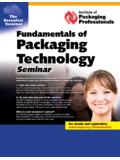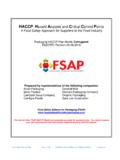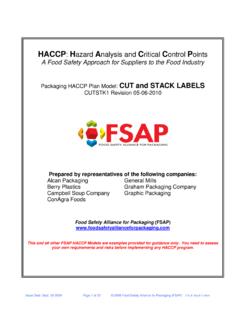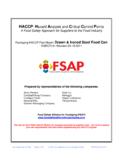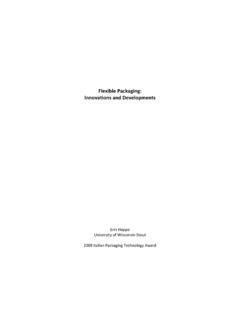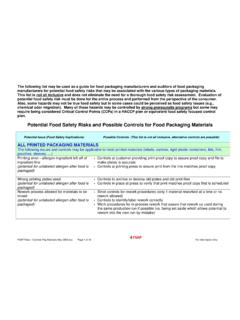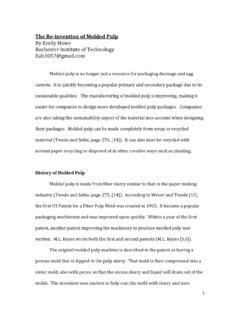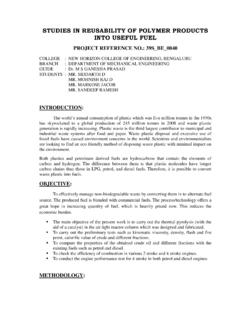Transcription of PLA: a Critical Analysis - IoPP
1 PLA: A Critical Analysis Casey Kingsland Mohawk College of Applied Arts and Technology 2010 Italian Packaging Technology Award February 12, 2010 2 PLA: A Critical Analysis Introduction Today the world is quickly coming to realize the impact of packaging on human life. The world is beginning to see the effects of our existence on the planet. This has sparked a major movement towards maintaining society s thirst for goods while improving the footprint left on our planet. Public perception can play a major role in pointing fingers and identifying the culprit as well as being quick to praise a lofty idea as a solution.
2 One of the major targets of public finger pointing is packaging. Packaging is easily seen by everyone, on the ground, in their garbage and ultimately in the landfill (Figure 1). Although this is a legitimate concern that is of great importance, the general public needs to be better educated in order to understand why packaging exists. Packaging is a necessary part of exchanging goods around a country and the world. The way consumers buy goods demands protection and preservation. Figure 1: Mexican garbage dump (earth first) 3 So what can be done to start to manage this waste that comes from our consumption?
3 A solution that is generating a lot of buzz around the industry is polylactic acid (PLA). PLA has been stated by some to be an environmentally friendly polymer (Reeves). This sustainable idea is the catalyst behind bringing this polymer to the forefront of innovative materials. In an article on packaging trends, seven packaging professionals were asked what they thought some of the major trends of 2010 would be. All of them answered that sustainability would be one of the major trends to affect packaging in 2010 (Figure 2, Kalkowski).
4 Polylactic Acid (PLA) PLA is produced from a renewable resource; corn. The corn is harvested and then milled to extract the starch from the raw materials. From the starch, dextrose is produced. The dextrose is then fermented, transforming into lactic acid. The lactic acid is altered into a polymer by a chemical process called condensation, thus forming long chain molecular compounds into Figure 2: Packaging trends in 2010 (Kalkowski) Figure 2: Trends for 2010 4 polylactic acid (Balkcom). PLA can be modified to run in conventional forming systems such as; injection molding, blow molding, thermoforming, and sheet extrusion (Balkcom).
5 After forming, PLA can hold its shape and be used as a package under normal conditions. However once exposed to the proper combination of oxygen, moisture and naturally occurring organisms, it will break down into carbon dioxide, water and a small amount of non toxic waste (Reeves). Some studies have shown that it can take as long as 15 months for PLA to start to decompose, even in a controlled composting environment (Rudeekit). Bioplastics like PLA are a new idea for replacing petroleum based polymers. PLA belongs to group of polymers known as aliphatic polyesters.
6 This family of polymers is usually made from hydroxy acids. Another biodegradable polymer that belongs to this group is: PolyHydroxy-Alkanoate (Figure 3, L. Averous). PolyHydroxy-Alkanoates are commonly used in pharmaceutical applications such as sutures, nerve guides and surgical mesh due to their biodegradable attributes (Bio Portfolio). Figure 3: Biodegradable polymers classification (Averous) 5 It is estimated that 42,000 metric tons of biodegradable packaging was used in 2006; of which PLA accounted for approximately 17%.
7 It is projected that this number could be as high as 116,000 metric tons by 2011 with PLA experiencing similar growth (Packaging Digest, CAGR). Although PLA is not a commonly used material, some companies have found specific uses for the material such as: Bags for salads. Salad bags and similar fresh food (Figure 4) applications accounted for 42% of PLA use in 2006. It is thought that the food service industry is the most likely source of growth and it is projected that the use of PLA could experience a 24% compound annual growth rate (Packaging digest, CAGR).
8 Companies that use PLA are generally those who are promoting a culture of sustainability and organic wholesomeness (Reeves). Coca-Cola is another company that is looking to implement PLA into its operation (Figure 5). They are currently developing a PET Plant Bottle that will contain 25% PLA (Kalkowski). This however could make an existing PET bottle that is recyclable, no longer recyclable as well as non bio-degradable. Mixing the two components together would make separation at a recycling level impossible which could force the bottles into the landfill.
9 This is the type of Critical thinking that is necessary when assessing a new idea. Figure 3: Biodegradable polymers classification (Averous) Figure 4: PLA Bag (Packaging digest, CAGR) Figure 5: Plant Bottle (Coca-Cola) 6 Mirel s thermoformed cups. Another biopolymer that is worth mentioning is polyhydroxyalkanoate (PHA). PHA resins are known as aliphatic polyesters, or a family of polymers that are made biologically by converting sunlight and carbon dioxide from the atmosphere using microbial or plant biofactories as described by Anne-Marie Mohan, senior editor at Packaging Digest magazine.
10 This corn and sugar based resin material has been put to use by Mirel for the production of thermoformed cups (Figure 6). Properties of the PHA cups are stated to be comparable to polypropylenes, offering good stiffness and tensile strength (Mohan). Obstacles Some of the problems with PLA are with its production. A massive amount of corn is needed to produce PLA: but where is it going to come from and at what cost? Based on the projections in Figure 7 of 116,000 metric tons of PLA in use by 2011, the demand for corn can be calculated using the conversion of kg of corn needed to produce 1 kg of PLA ( ).

